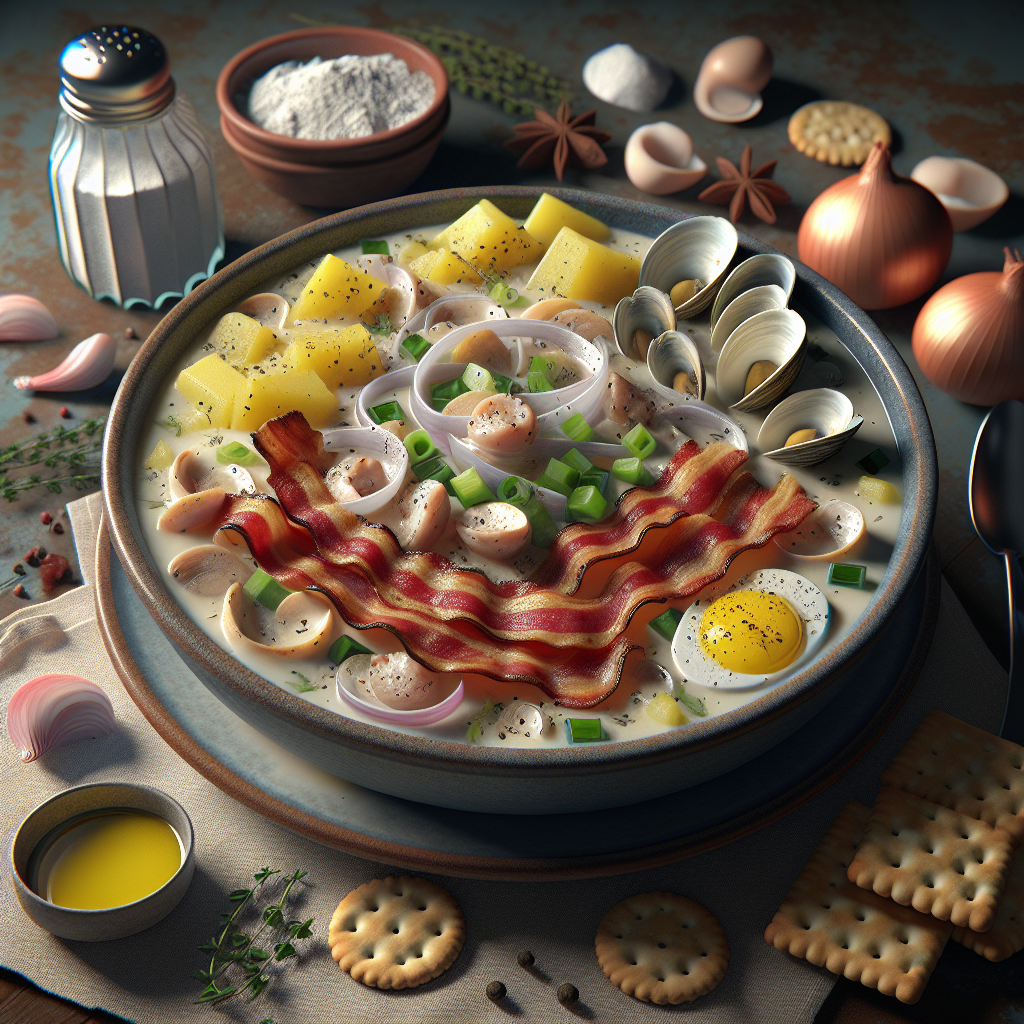
Master the art of creating the richest, creamiest New England Clam Chowder right in your own kitchen. This traditional recipe features tender clams, crispy bacon, and perfectly cooked potatoes in a velvety cream base. Topped with crispy oyster crackers, it's the ultimate bowl of coastal comfort.
Ingredients for Authentic New England Clam Chowder: A Comforting Seafood Classic
- 4oz Bacon
- 5oz Yellow Onion, diced
- 2stalks Celery Stalks, diced
- 1oz All-Purpose Flour
- 14oz Yukon Gold Potatoes, diced
- 16oz Clam Juice
- 14oz Chopped Clams, drained
- 12oz Heavy Cream
- 2 tsp Fresh Thyme
- 1leaf Bay Leaf
- 1 tsp Salt
- 1 tsp Black Pepper
- 3.5oz Oyster Crackers
Instructions for Authentic New England Clam Chowder: A Comforting Seafood Classic
- In a large pot over medium heat, cook 4oz bacon until crispy, about 5-7 minutes. Remove bacon with a slotted spoon and set aside, leaving the fat in the pot.
- Add 5oz diced onion and 2stalks celery to the pot. Cook until vegetables are softened, about 5 minutes.
- Sprinkle 1oz flour over the vegetables and stir constantly for 1 minute.
- Slowly add 16oz clam juice while stirring continuously to prevent lumps.
- Add 14oz diced potatoes, 2 tsp thyme, and 1leaf bay leaf. Bring to a simmer and cook until potatoes are tender, about 15 minutes.
- Stir in 14oz chopped clams and 12oz heavy cream. Simmer for 5 minutes.
- Season with 1 tsp salt and 1 tsp black pepper. Remove bay leaf.
- Serve hot, topped with the reserved crispy bacon and 3.5oz oyster crackers.
Delving into a Bowl of Authentic New England Clam Chowder
There's something magical about a steaming bowl of New England Clam Chowder that just speaks to the soul. This isn't just any soup - it's a cherished tradition that's been warming hearts and bellies along the Atlantic coast for generations. With its rich, creamy base, tender clams, and perfectly cooked potatoes, this classic recipe stays true to its roots while being completely achievable in your own kitchen.
This recipe yields a chowder that strikes the perfect balance between comfort and elegance. In about an hour (15 minutes prep and 45 minutes cooking time), you'll create a restaurant-quality dish that serves 4 people generously. Each spoonful delivers tender chunks of clams, perfectly diced potatoes, and crispy bacon bits swimming in a velvety cream broth that's been carefully seasoned with fresh thyme and traditional spices.
What makes this version truly authentic is its commitment to the classic preparation method - starting with rendering bacon fat for depth of flavor, using both clam juice and fresh clams for that genuine seafood taste, and finishing with just the right amount of heavy cream to achieve that signature New England consistency - not too thick, not too thin, but just right.
Tips for the Perfect New England Clam Chowder Every Time
Let me share some hard-earned wisdom that'll help you nail this chowder on your first try:
-
Don't rush the bacon step! Those 5-7 minutes of cooking are crucial for rendering out the fat properly. This creates the flavor foundation for your entire chowder.
-
When adding the flour to the vegetables, keep stirring constantly. This prevents any floury lumps and ensures a smooth, silky chowder.
-
Dice your potatoes uniformly (about 1/2 inch cubes) so they cook evenly. I prefer Yukon Golds because they hold their shape while still becoming tender and creamy.
-
When adding the clam juice, pour it in gradually while stirring. This technique, called tempering, prevents lumps and creates a smooth base.
-
Don't overheat the chowder after adding the cream. A gentle simmer is all you need - boiling can cause the cream to separate and give your chowder a grainy texture.
-
For the best flavor, try to find fresh clams, but high-quality canned clams work well too. Just make sure to drain them properly.
Serving Your New England Clam Chowder in Style
This chowder deserves to be served with a bit of flair! I recommend warming your bowls slightly before ladling in the hot chowder - this restaurant trick keeps your soup hotter longer. Top each serving with a generous sprinkle of the reserved crispy bacon bits and a handful of oyster crackers (3.5 oz/100g total for garnishing).
For a complete meal, serve your chowder with a crisp green salad and some crusty sourdough bread for dunking. If you're hosting a dinner party, consider serving it as a starter in smaller portions - though I warn you, people might not want to move on to the main course!
Remember those nutrition facts when planning your meal - each serving contains 520 calories, making it a satisfying main course on its own. The 25g of protein per serving means it's quite filling, while the 32g of fat delivers that signature richness we all love in a good chowder.
From My Kitchen to Yours: A Chowder Story
I'll never forget my first attempt at making New England Clam Chowder. It was during my first winter after moving to Boston for work, and I was desperately homesick for my mother's cooking. The local seafood shop owner, a weathered gentleman named Bob, saw me eyeing the clams and shared his family's recipe - quite similar to this one - along with a wealth of tips and stories about the dish's history.
My first batch was a disaster - I rushed the bacon, scorched the cream, and ended up with something that looked more like chunky milk than chowder. But Bob encouraged me to try again, and over time, this recipe became my go-to comfort food. Now, years later, I've perfected this version, which combines traditional techniques with practical modern adjustments.
This recipe reminds me of those early days in Boston, of learning to cook through trial and error, and of the kindness of strangers who become friends. Every time I make it, especially on cold winter evenings, I think of Bob and how this humble soup helped make a new city feel like home.
Make It Your Own: Smart Substitutions for New England Clam Chowder
As someone who's made countless pots of clam chowder, I know that sometimes you need to work with what you have on hand. Here are some tried-and-true substitutions that won't compromise the authentic taste of your New England Clam Chowder:
For the dairy component, if heavy cream isn't available, you can use half-and-half or a combination of whole milk and butter. While the result won't be quite as rich, it'll still be delicious. Just avoid low-fat alternatives as they might lead to a thinner consistency.
The Yukon Gold potatoes can be swapped with russet potatoes, though they might break down a bit more during cooking. Red potatoes are another excellent option as they hold their shape well.
When it comes to the clams, while fresh is fantastic, high-quality canned clams work perfectly in this recipe. If you can't find clam juice, you can use seafood stock or even a combination of chicken stock and water with a touch of fish sauce for that seafood essence.
For our bacon-averse friends, salt pork is actually a traditional alternative, or you could use smoked turkey bacon for a lighter option. The key is to keep that smoky flavor that adds depth to the chowder.
Fresh thyme can be replaced with dried thyme (use 3/4 teaspoon instead of 2 teaspoons), and if you're out of oyster crackers, Westminster crackers or even crushed saltines make great toppings.
Nutrition Facts: What's in Your Bowl of Clam Chowder?
Let's be honest - New England Clam Chowder isn't trying to win any low-calorie awards, but it's packed with nutritional benefits that might surprise you. Each generous serving (approximately 1 1/2 cups) contains:
- Calories: 520
- Total Fat: 32g
- Carbohydrates: 38g
- Sugar: 4g
- Protein: 25g
The clams in this chowder are nutritional powerhouses, providing high-quality protein and being an excellent source of iron, vitamin B12, and zinc. They're also rich in omega-3 fatty acids, which support heart and brain health.
The potatoes contribute essential vitamins and minerals, including vitamin C and potassium, while also providing filling complex carbohydrates. The combination of protein from the clams and carbohydrates from the potatoes makes this a satisfying meal that will keep you feeling full.
Allergen Alert: Important Information About This Chowder
As a chef who takes food safety seriously, I want to ensure everyone can enjoy this chowder safely. This recipe contains several common allergens that you should be aware of:
- Shellfish (clams): A major allergen and the star ingredient
- Dairy (heavy cream): Contains milk proteins
- Gluten (all-purpose flour and oyster crackers): Present in both the thickener and topping
Cross-contamination can also be a concern, especially with shellfish. If you're preparing this for someone with allergies, ensure all utensils and surfaces are thoroughly cleaned before cooking.
For those with celiac disease or gluten sensitivity, the flour can be replaced with a gluten-free all-purpose flour blend, and gluten-free crackers can be used for topping. However, this dish may not be suitable for those with severe shellfish allergies.
Storage Solutions: Keep Your Chowder Fresh
Properly storing your New England Clam Chowder is crucial for maintaining its quality and safety. Here's what you need to know:
Refrigeration: Transfer cooled chowder to an airtight container and store in the refrigerator for up to 3 days. The fats may solidify on top - this is completely normal and will reincorporate when reheated.
Freezing: While possible, I don't typically recommend freezing this chowder as the dairy can separate and the potatoes may become grainy. However, if you must freeze it, store it in an airtight container for up to 2 months. Thaw overnight in the refrigerator.
Reheating: Warm gently over low heat on the stovetop, stirring occasionally. Add a splash of cream or milk if needed to reach desired consistency. Avoid boiling as this can cause the dairy to separate.
Frequently Asked Questions About New England Clam Chowder
Q: Can I use fresh clams instead of canned? A: Absolutely! You'll need about 4-5 pounds of fresh clams in shells. Steam them first and use the cooking liquid as your clam juice.
Q: Why did my chowder turn out too thin? A: This usually happens if the flour wasn't cooked long enough with the vegetables or if it was boiled too vigorously. Remember to simmer gently and give the flour time to cook out.
Q: Can I make this ahead for a party? A: Yes! It actually tastes better the next day. Just reheat gently and adjust seasonings before serving.
Q: My chowder curdled, what happened? A: This typically occurs when the soup is heated too quickly or brought to a boil. Always heat cream-based soups gently and never let them boil.
The Perfect Bowl of Comfort: Final Thoughts on New England Clam Chowder
This New England Clam Chowder recipe represents everything I love about classic American cooking - it's hearty, comforting, and carries decades of coastal tradition in every spoonful. While it might seem intimidating at first, this recipe breaks it down into manageable steps that even novice cooks can master.
Remember, the key to perfect chowder lies in patience - don't rush the process of softening the vegetables or incorporating the flour. Let each step build the flavors that make this soup so special. Whether you're serving it on a cold winter evening or as part of a summer seafood feast, this chowder is sure to become a favorite in your recipe collection.
The beauty of this recipe is its versatility - it can be dressed up for special occasions or served casually for a family dinner. Whatever the setting, one thing remains constant: there's nothing quite like a steaming bowl of homemade New England Clam Chowder to warm both body and soul.
